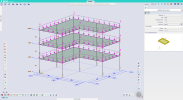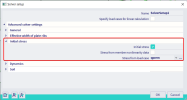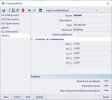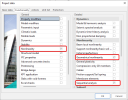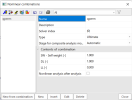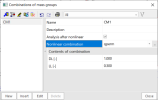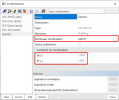P-delta effects in seismic analysis
Introduction
In case second-order effects (P-delta) need to be taken into account in a seismic analysis, it can/should be done at several levels in SCIA Engineer.
P-delta effects affect the dynamic behaviour
Compression in supporting members (columns, walls) amplifies the sway of the structure. Natural periods and lateral displacements tend to increase.
That can be considered in the analysis by adding a so-called geometric stiffness component in the stiffness matrix of supporting members, causing them to appear softer.
It is, by the way, the same geometric stiffness component that causes cables to appear transversally stiffer when under tension. Members under tension appear transversally stiffer, members under compression appear transversally softer, due to second-order effects.
Seismic load cases computed via spectral analysis use a modal superposition of mode shapes, which, consequently, will include P-delta effects as well.
Please note a fundamental assumption of 2nd order theory: P-delta effects are based on a predefined axial stress state in members. Therefore, the analysis is valid as long as compression forces in supporting members is not modified significantly by transversal loading.
In SCIA Engineer
There are two approaches that allow to consider P-delta effects in a seismic analysis in SCIA Engineer:
- Use initial stresses - that approach allows to consider P-delta effects in the modal analysis and their effect on natural periods and mode shapes, using the stress state obtained from a single load case. That approach is supported in all versions of SCIA Engineer.
- Use sequential analysis - that approach allows to use the results of a nonlinear analysis - e.g. second-order analysis under permanent static loading - as initial stress state for the modal analysis. The results obtained from the subsequent seismic spectral analysis can then be combined again with the results of the permanent nonlinear combination. At the moment, sequential analysis is supported only in the 32-bits version of SCIA Engineer, using 'v16 and older' post-processing environment. Sequential analysis is included in the Expert and Ultimate editions of SCIA Engineer.
A. P-delta effects using initial stresses
This approach is supported in all versions of SCIA Engineer. It requires no additional license than what is needed for standard seismic analysis.
This approach requires that a load case is defined, that reproduces the desired initial state - i.e. quasi-permanent state - for the seismic analysis.
It also implies, that only the modal seismic spectral analysis will be carried out with P-delta effects. The quasi-permanent state will be computed linearly.
A.1 Project settings
Only regular project settings for seismic analysis are needed. Initial stress functionality is enabled by default.
A.2 Initial stress input
Create a load case that contains all permanent and quasi-permanent loads.
In the example below:
- surface loads on all slabs:
- self-weight = 0.2 * 2.5 * 9.81 = 4.905 kN/m2
- dead load = 3 kN/m2
- quasi-permanent part of live load = 0.3 * 2 = 0.6 kN/m2
- total = 8.505 kN/m2
- self-weight line loads on all columns
A.3 Solver settings
In solver settings, enable initial stress and select the correct load case for initial stress state.
A.4 Combine static & seismic results
The seismic load case combination is defined exactly in the same way as for a normal linear analysis.
Create a linear seismic combination containing
- the static load cases included in the quasi-permanent state
- the seismic load cases
B. P-delta effects using sequential analysis
This approach is supported only in the 32-bits version of SCIA Engineer in 'v16 and older' post-processing environment. The sequential analysis feature is included in the Expert and Ultimate editions of SCIA Engineer.
In this approach, the initial state is defined simply by creating a nonlinear combination containing the load cases for the quasi-permanent state (this makes it simpler to apply than the approach with initial stresses).
It also implies, that both the static initial state and the seismic spectral analysis will be computed with P-delta effects.
B.1 Project settings
Additionally to regular seismic functionality, enable nonlinearity, geometric nonlinearity and sequential analysis.
B.2 Initial state
Create a nonlinear combination. That will serve as initial state for the modal and seismic analysis.
B.3 Assign initial state
In the combination of mass groups, select the nonlinear combination that defines the initial state.
At this point, running a linear analysis will trigger automatically, in turn:
- the nonlinear analysis of nonlinear combination qperm, which is required for modal analysis
- the modal analysis of combination of mass groups MC1, which is required for spectral analysis of seismic load cases
- the linear analysis of all remaining static load cases
B.4 Combine static & seismic results
Sequential analysis also allows combining the results from a nonlinear combination with one or more linear load cases.
Create a linear seismic combination containing
- the nonlinear combination (qperm) defined for the initial state
- the seismic load cases
Results
Comparing results from 3 approaches:
- linear analysis - without P-delta effects
- initial stress - with P-delta effects in modal and seismic spectral analysis
- sequential analysis - with P-delta effects in static initial state and in modal and seismic spectral analysis
Modal analysis
| Period | |||
| Mode | without P-delta | initial stress | sequential analysis |

|

|

|
|
| 1 | 2.47 s | 2.93 s | 2.93 s |
| 2 | 1.94 s | 2.10 s | 2.10 s |
| 3 | 1.65 s | 1.80 s | 1.80 s |
| 4 | 0.63 s | 0.66 s | 0.66 s |
Displacements under seismic loading
| Displacement | |||
| Storey | without P-delta | initial stress | sequential analysis |
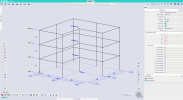
|
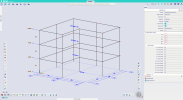
|
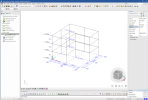
|
|
| 3 | 11.5 mm | 13.3 mm | 13.3 mm |
| 2 | 9.5 mm | 11.2 mm | 11.2 mm |
| 1 | 6.1 mm | 7.3 mm | 7.3 mm |
Total shear force per storey
| Shear force | |||
| Storey | without P-delta | initial stress | sequential analysis |
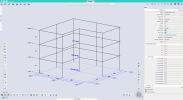
|
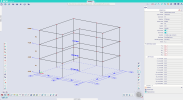
|

|
|
| 3 | 15.41 kN | 15.30 kN | 15.30 kN |
| 2 | 28.35 kN | 28.30 kN | 28.30 kN |
| 1 | 36.61 kN | 36.73 kN | 36.73 kN |
Bending moment in a column under seismic load case alone
| Max moment in column | |||
| Storey | without P-delta | initial stress | sequential analysis |
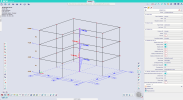
|

|
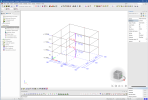
|
|
| 3 | 9.95 kNm | 10.75 kNm | 10.75 kNm |
| 2 | 16.26 kNm | 18.58 kNm | 18.58 kNm |
| 1 | 22.40 kNm | 26.51 kNm | 26.51 kNm |
Bending moment in a column under seismic combination
Note: here, the values in the column 'initial stress' do not include second-order effects for the static load cases.
| Max moment in column | |||
| Storey | without P-delta | initial stress | sequential analysis |
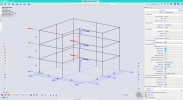
|
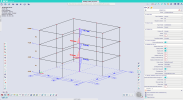
|
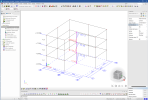
|
|
| 3 | 67.97 kNm | 68.77 kNm | 68.73 kNm |
| 2 | 53.52 kNm | 55.84 kNm | 55.96 kNm |
| 1 | 49.80 kNm | 53.92 kNm | 53.95 kNm |


